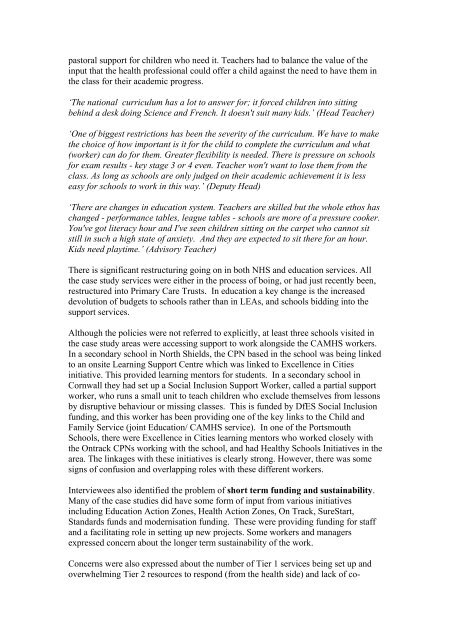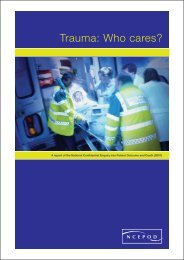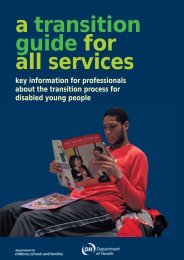(CAMHS) and Schools - London Health Programmes
(CAMHS) and Schools - London Health Programmes
(CAMHS) and Schools - London Health Programmes
You also want an ePaper? Increase the reach of your titles
YUMPU automatically turns print PDFs into web optimized ePapers that Google loves.
pastoral support for children who need it. Teachers had to balance the value of the<br />
input that the health professional could offer a child against the need to have them in<br />
the class for their academic progress.<br />
‘The national curriculum has a lot to answer for; it forced children into sitting<br />
behind a desk doing Science <strong>and</strong> French. It doesn't suit many kids.’ (Head Teacher)<br />
‘One of biggest restrictions has been the severity of the curriculum. We have to make<br />
the choice of how important is it for the child to complete the curriculum <strong>and</strong> what<br />
(worker) can do for them. Greater flexibility is needed. There is pressure on schools<br />
for exam results - key stage 3 or 4 even. Teacher won't want to lose them from the<br />
class. As long as schools are only judged on their academic achievement it is less<br />
easy for schools to work in this way.’ (Deputy Head)<br />
‘There are changes in education system. Teachers are skilled but the whole ethos has<br />
changed - performance tables, league tables - schools are more of a pressure cooker.<br />
You've got literacy hour <strong>and</strong> I've seen children sitting on the carpet who cannot sit<br />
still in such a high state of anxiety. And they are expected to sit there for an hour.<br />
Kids need playtime.’ (Advisory Teacher)<br />
There is significant restructuring going on in both NHS <strong>and</strong> education services. All<br />
the case study services were either in the process of boing, or had just recently been,<br />
restructured into Primary Care Trusts. In education a key change is the increased<br />
devolution of budgets to schools rather than in LEAs, <strong>and</strong> schools bidding into the<br />
support services.<br />
Although the policies were not referred to explicitly, at least three schools visited in<br />
the case study areas were accessing support to work alongside the <strong>CAMHS</strong> workers.<br />
In a secondary school in North Shields, the CPN based in the school was being linked<br />
to an onsite Learning Support Centre which was linked to Excellence in Cities<br />
initiative. This provided learning mentors for students. In a secondary school in<br />
Cornwall they had set up a Social Inclusion Support Worker, called a partial support<br />
worker, who runs a small unit to teach children who exclude themselves from lessons<br />
by disruptive behaviour or missing classes. This is funded by DfES Social Inclusion<br />
funding, <strong>and</strong> this worker has been providing one of the key links to the Child <strong>and</strong><br />
Family Service (joint Education/ <strong>CAMHS</strong> service). In one of the Portsmouth<br />
<strong>Schools</strong>, there were Excellence in Cities learning mentors who worked closely with<br />
the Ontrack CPNs working with the school, <strong>and</strong> had <strong>Health</strong>y <strong>Schools</strong> Initiatives in the<br />
area. The linkages with these initiatives is clearly strong. However, there was some<br />
signs of confusion <strong>and</strong> overlapping roles with these different workers.<br />
Interviewees also identified the problem of short term funding <strong>and</strong> sustainability.<br />
Many of the case studies did have some form of input from various initiatives<br />
including Education Action Zones, <strong>Health</strong> Action Zones, On Track, SureStart,<br />
St<strong>and</strong>ards funds <strong>and</strong> modernisation funding. These were providing funding for staff<br />
<strong>and</strong> a facilitating role in setting up new projects. Some workers <strong>and</strong> managers<br />
expressed concern about the longer term sustainability of the work.<br />
Concerns were also expressed about the number of Tier 1 services being set up <strong>and</strong><br />
overwhelming Tier 2 resources to respond (from the health side) <strong>and</strong> lack of co-

















